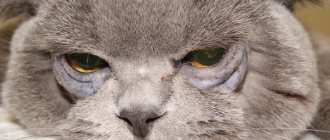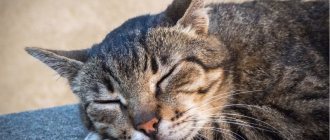Victoria Rashidovna Khazimulina
veterinarian Petstory
Tartar in cats is a fairly common problem, especially in animals over 6 years of age. Its formation depends on the type of feeding, breed, drinking regime, genetics and the presence of oral diseases. In this article we will tell you how to avoid its formation and how to get rid of it.
- Specialized feed
Stones on the teeth of cats: the main thing
- Tartar is a brown or yellow build-up on teeth made up of bacteria, food debris and lime deposits.
- Dental plaque harms not only the oral cavity, but also the digestive organs, respiratory system and even the eyes.
- The main reason for the formation is insufficient oral hygiene and gum disease.
- The most susceptible to the formation of plaque on teeth are cats of brachycephalic breeds (with a short muzzle) and cats over 6 years of age.
- The main symptoms are bad breath, reddening of the gums, characteristic plaque and growths on the teeth.
- The diagnosis can be made by careful examination of the oral cavity.
- Stone removal is possible only with an ultrasonic scaler; other methods are effective only at an early stage.
- Prevention consists of oral hygiene (brushing teeth, special food, using toothpick treats).
How is a tumor removed in veterinary clinics?
Clinics have special tools for removing tartar from the teeth of four-legged patients. The procedure itself is unpleasant and painful, so it is often performed under general anesthesia in a clinic setting.
Before choosing a stone removal method, the doctor determines where it is located. You can get rid of the formation mechanically or using ultrasound.
Mechanical chipping is performed with a special dental blade - a skeller. The surface of the units is first treated with lactic acid so that the stone comes off better. When manually removed, there is a risk of accidentally damaging the gums or compromising the integrity of the tooth surface. For this reason, ultrasonic cleaning is preferable.
This procedure can last from 40 minutes to several hours. Before surgery, the animal should not be fed for 12 hours. Cats aged 5 years and older need to undergo a preliminary examination to make sure that the anesthesia will not harm their body.
The animal is fixed in a lying position and the mouth is treated with iodine solution: this helps to remove saliva from the surface of the teeth. After this, the enamel is polished with ultrasound. The treated areas after such an operation are lubricated with an antiseptic.
The first days after ultrasonic cleaning, the animal may experience discomfort and pain. In this case, the veterinarian will prescribe him a painkiller. After surgery, your pet should be fed warm, semi-liquid food.
What is tartar?
Tartar is a hard build-up on teeth that is made up of a mixture of bacteria, limescale deposits and food debris.
It all starts with the fact that cats develop plaque on their teeth, consisting of food debris. Bacteria enter this environment, feel comfortable there and actively multiply.
Due to the vital processes of microorganisms (rotting, oxidation), an unpleasant odor emanates from the mouth.
Bacteria always live in the oral cavity and are usually harmless, but when actively multiplying, they cause tissue inflammation. Over time, dental plaque becomes denser and thicker, mineral compounds begin to settle in it, and due to this it gradually hardens. The color of the stone can range from yellow-gray to brown, sometimes with green inclusions (due to fungal growth).
Depending on the microbiome and the type of salts, the stones on cats' teeth come in different densities. And they can form at different speeds. At the very beginning, dental deposits are soft and can be brushed off. But as it hardens, due to the vital processes of bacteria, the stone will cover an increasingly larger area of the tooth, strengthen and destroy the enamel. It is important to remember that tartar and plaque form not only on the surface of the tooth, but also in the subgingival space.
Plaque prevention
As for preventive measures, it is enough to follow simple rules so that you will never again wonder how to remove tartar at home. Proper care includes the following:
- Complete cessation of unhealthy habits. We are talking about smoking, consumption of excessive amounts of sweets, coffee and black tea that affect dental health.
- Quality food. Regular consumption of fresh vegetables, herbs and dairy products helps cleanse the enamel.
- Purchase a new toothbrush every month.
- Regular visits to the dentist. It is recommended to visit a dentist once every six months.
Danger to the animal
Tartar is dangerous not only for the teeth and gums, but also for other organ systems of the cat. Let's discuss the most common complications:
- First of all, the oral cavity suffers. The enamel is destroyed, the constant presence of bacteria causes decay processes and provokes pathological processes (periodontitis, gingivitis, stomatitis, caries, periostitis). This is accompanied by redness and pain. Over time, if left untreated, teeth will begin to rot and fall out.
- Inflammation of the roots of the teeth can develop into gumboil or an abscess in the muzzle area.
- Painful chewing will reduce appetite, and the animal will not receive enough nutrients, which will affect its health.
- Bacteria from the oral cavity constantly enter the gastrointestinal tract and respiratory tract, which increases the risk of diseases of these organ systems (enteritis, pneumonia, etc.).
- Eye diseases. The cat licks itself, and bacteria from the mouth constantly gets into the mucous membranes of the eyes, which can cause inflammation.
- Rhinitis, rhinoconjunctivitis. The nasal cavity is located in close proximity to the oral cavity; they communicate in the pharynx. Thus, inflammatory processes in the mouth can easily provoke rhinitis (inflammation of the nasal passages). And rhinitis can turn into conjunctivitis due to the nasolacrimal duct, which runs between the nose and the inner corner of the eye. It is not uncommon for animals with advanced cases to have chronic discharge from the eyes or nose.
Prevention
Acute toothache is considered the most severe after childbirth. Therefore, so that your pet does not have to experience it, you need to take the following preventive measures:
- Teeth cleaning
It is recommended to use special toothpastes with different flavors and brushes. There are regular and massage brushes, alternate between them.
Read more: How to brush your cat's teeth
- Balanced diet
The optimal choice is professional super-premium and holistic-class food. Not only will they not harm your pet (unlike cheap food), but they will also provide him with all the necessary vitamins and minerals. At the Murkosha shelter, cats receive exactly this kind of food.
Read about food: What food to feed your cat
You can also purchase dried tendons for cleaning your teeth.
- Treatment of gastrointestinal diseases
They disrupt the acid-base balance of the oral cavity.
- Preventative visit to the veterinarian
At a minimum, this should be done once a year, preferably every six months (and if the pet is over 10 years old, then it is mandatory).
More information about a planned visit to the doctor: Annual visit to the veterinarian - what is included and why it is needed
Causes of tartar
In cats, it all starts with dental plaque, which is formed from food debris. Accordingly, the main reason for the formation of stones is insufficient oral hygiene.
Additional factors are:
- Soft food. Pastes, mousses, porridges will settle more easily on the walls of the teeth.
- Small feed granules. If the granules are not chewed, but swallowed, there is no cleaning of the teeth, and the plaque progresses.
- Age. By the age of 6-8 years, cats usually already have dental plaque. There is nothing wrong with this, you just need to get rid of them in time before problems arise.
- Oral diseases. Firstly, if your pet has these diseases (gingivostomatitis, calicivirus, etc.), then he will not be able to chew normally, which will increase the formation of plaque. And secondly, there will be more bacteria in the oral cavity during inflammation, and they are responsible for the hardening of plaque.
- Breed predisposition. The stone is more actively formed in animals with a flat muzzle due to the structural features of the jaw (more details below).
Who's at risk
Tartar forms especially intensively in pets with a flattened muzzle (Persian, exotic, British, etc.). Due to the peculiarities of their jaw structure, these cats often grasp food incorrectly and cannot chew it well. They also often have an abnormal arrangement of teeth, pockets and crevices form into which food gets clogged and, over time, tartar forms.
Elderly animals are also at risk. In them, as a rule, the stone grows for a long time without symptoms; owners may not notice it until the problem becomes acute. For cats over 6 years old, an annual examination by a veterinarian is recommended (can be combined with vaccination).
Reasons for education
In veterinary medicine, there are several reasons that influence the formation of tartar:
- Improperly balanced cat nutrition. The lack of natural food leads to the formation of microorganisms, which, when interacting with saliva, lead to the formation of deposits.
- Incorrectly formed bite.
- Metabolic disorders in the cat’s body lead to improper salt metabolism, resulting in the growth of tartar.
- Insufficient oral care.
- The presence of inflammation of the gums.
Symptoms
The first symptoms are always bad breath and red gums. But the cat seems healthy. As it progresses, signs of oral disease will increase and worsen.
Symptoms of tartar in cats (as they progress):
- bad breath (halitosis);
- redness of the gums (gingivitis, stomatitis);
- bleeding gums;
- growths on teeth that are yellow, gray or brown (sometimes greenish due to fungal growth);
- chewing disorders - chewing on one side, grinding;
- decreased appetite;
- swelling in the cheekbones and lower jaw;
- pain when touching the gums or face;
- discharge from the eyes, nose;
- excessive salivation (hypersalivation).
Service price
| Service | Unit change | Price, rub |
| Mechanical tartar removal | 1 tooth | 100 |
| Sanitation of the oral cavity by mechanical means without signs of gingivitis | 1 head | 1500 |
| Mechanical sanitation of the oral cavity for gingivitis | 1 head | 2500 |
| Ultrasonic tartar removal (without the cost of anesthesia) | 1 tooth | 150 |
| Sanitation of the oral cavity with ultrasound without signs of gingivitis (without the cost of anesthesia) | 1 head | 3000 |
| Sanitation of the oral cavity with ultrasound for gingivitis (without the cost of anesthesia) | 1 head | 3000-7000 |
View all prices
Tartar removal in cats
Complete removal of tartar can only be achieved using an ultrasonic scaler under anesthesia. All other methods are suitable for cleaning plaque or early stone (when it is still soft and can be brushed off).
The main means used to remove tartar in cats are:
Specialized feed
Feeds designed to combat tartar actually show their effectiveness, but only in the very early stages.
The bottom line is that the food has a certain size and kibble texture, due to which it seems to be pressed onto the tooth, and does not crumble immediately, which helps clean and massage the gums. Also, such diets, as a rule, contain components that reduce the formation of lime deposits. If the growths are significant, these foods will not clean your teeth. In addition, there are hard-to-reach places on the teeth that most likely will not be cleaned completely, and some cats even chew only with their front teeth.
Hurry up, choose a box and find out what gift awaits you
Discount on pet insurance
Promo code copied to clipboard
Tartar removers
In the early stages, a paste or gel can be used to remove tartar in cats. These drugs are effective only when used correctly. They need to thoroughly brush your teeth at least once every 3 days.
There are also “toothpicks” that can be given as treats once a day. Their effectiveness and operating principle are the same as those of food. But it is important not to exceed the daily requirement, since they consist of dense fibers and can cause diarrhea if taken in excess.
Various plant-based liquids in the form of sprays and gels do not help get rid of stones, but will fight inflammation and have a healing effect on the gums.
Mechanical teeth cleaning
Here we mean cleaning with special tools from a veterinarian. Dental instruments are usually used for this. Such cleaning will not get rid of subgingival stone, will not properly clean the enamel, and will not help remove deposits in hard-to-reach places. In addition, there is a risk of damage to the tooth itself. This method is ineffective and sometimes dangerous. After mechanical cleaning, the stone usually grows back quite quickly.
Sanitation (cleaning) with an ultrasonic scaler
The most effective way to get rid of tartar in cats is cleaning with an ultrasonic scaler. During sanitation, the doctor uses a special pen with a metal attachment at the end. This nozzle emits ultrasound, and at the same time a thin stream of solution enters it from a special hole. Due to the combination of ultrasound and liquid, tartar is destroyed. The tooth itself is not damaged.
But no cat in its right mind would allow a whistling device, and one that splashes water, to get into its mouth. Therefore, although the procedure is almost painless, sedation (light anesthesia) is used. This way you can avoid stress for your pet and thoroughly clean hard-to-reach places. After sanitation, it is recommended to polish the tooth enamel so that subsequent tartar formation is as slow as possible. The procedure is often performed in clinics and is well tolerated by animals.
Removal
Removing tartar is a rather painful procedure that causes discomfort in the mustachioed one.
In order for your pet to undergo the procedure without stress and without pain, general anesthesia is used. The removal method is selected individually by a veterinarian and depends on the severity of the lesion:
- Laser removal - used for small stone sizes, if the pathological process has not yet affected the sinuses of the gums. This method is painless; anesthesia is necessary to immobilize the pet. The advantage of laser stone removal is that there is no risk of damage to enamel and soft tissue.
- Grinding – carried out with minor plaque. First, a special paste is applied to the teeth, which has a disinfecting and disinfecting effect. This paste helps even out tooth enamel. During the grinding process, partial removal of the enamel occurs and the gums may be injured. However, these complications are usually inevitable.
- Manual method . The procedure is carried out with special instruments and is used in severe cases of the disease, if there are plaques and extensive growths.
- Fluoridation is an additional step in the stone removal procedure that is recommended. The main task is to coat the crowns with a special varnish or gel containing sodium fluoride. Fluoridation reduces the increased sensitivity of dental tissue and has a strengthening effect on the enamel. In addition, fluoridation helps prevent the development of caries.
- Polishing is the final stage of the procedure. After grinding, the enamel remains rough, which greatly increases the likelihood of the stone forming again. To prevent relapse, the enamel must be polished to a perfectly smooth state. Polishing is carried out using specialized pastes and brushes.
Ban on anesthesia. There are cases when it is not possible to use anesthesia - these are:
- old age of the pet - anesthesia can cause negative consequences, including death;
- kidney, liver and heart diseases;
- abnormalities in the functioning of the central nervous system;
- tendency to allergic reactions.
If there is a risk of complications that could negatively affect the health of the animal, the procedure is carried out in several stages.
Actions after the procedure. After removing the pathological formation, it is recommended to give the cat painkillers, follow a diet, serving light, warm food. Painkillers should also be given if necessary. Due to the risks of relapse in the future, the owner should carefully monitor the condition of the pet’s oral cavity.
Prevention of tartar in cats
To prevent tartar in cats, you need to follow a few simple rules:
- Oral hygiene. You need to brush your cat’s teeth with a brush yourself, once every 1-3 days, or with a doctor with an ultrasound - once every 1-2 years.
- Drinking regime. Place several bowls and glasses of water around the apartment, especially where the cat likes to spend time. Change the water every day. If your pet loves to drink from the tap, you should consider purchasing a drinking fountain from a pet store. You can add a few drops of broth, wet food sauce, milk or lemon juice to the water. But the most important rule is that the bowl of water should be kept away from the bowl of food.
- Specialized food and toothpick treats. Their periodic use will slow down the formation of tartar or completely prevent its appearance.
- Annual examination by a veterinarian. It can be difficult to notice the first dental deposits. The doctor will be able to examine the oral cavity more thoroughly and take timely measures.
How to recognize a cat’s tendency to this disease?
If previously tartar was considered a disease characteristic of older cats, today it is increasingly detected in young animals. Most experts believe that the reason for this trend is an unbalanced diet, which leads to disruption of many metabolic processes.
Veterinarians identify risk groups that include certain breeds of cats that are susceptible to developing tartar. The owners of the Persians, British and Scots should be wary. The tendency to this disease among the named breeds is caused by the negligent attitude of low-skilled breeders towards their gene pool.
Semi-feral and barn cats, accustomed to eating exclusively natural food, are much less susceptible to the formation of tartar and other oral diseases. The reason for this is a much stable immunity compared to purebred relatives.
However, it is possible to protect your pet from such an unpleasant problem. The most important thing is to be careful and not delay visiting the veterinarian at the first suspicion that your animal has this disease.
Cleaning a cat's teeth at home: with what?
To clean your pet's mouth, you can use a special toothbrush for animals. On sale are:
- Toothbrushes with curved handles for ease of cleaning the mouth;
- Brushes that fit well and comfortably in the hand;
- Finger guards are brushes that can be placed on your finger.
If you don’t have a special one, you can use a soft children’s toothbrush. The bristles should fall just below the gum line. In extreme cases, it is appropriate to use gauze or a cotton swab.
Cat Teeth Cleaners
Pet pharmacies and veterinary stores sell special toothpastes for cleaning cats' teeth. They contain harmless substances, and cats really like the smell of the products.
Is it okay to use human toothpaste?
It is strictly forbidden to use the products on people, as they contain substances that should not be swallowed. A person can resist swallowing, but a cat can’t do that. If such a paste is swallowed, the pet may suffer, as its digestive system will receive substances harmful to it.
Is baking soda good for cleaning?
Baking soda contains a lot of alkali, which disrupts the acid balance in the stomach, so it should not be swallowed. The pet may not like the taste of the product, so it will break out and will not allow its teeth to be brushed.
We teach your pet to brush its teeth from a kitten
It is easier to accustom a small kitten to the procedure. If the cat is an adult, the procedure will take more time. At first this will cause certain difficulties, but then the pet will get used to it, so it will not pay attention to the procedure.
There are certain recommendations that, if followed, will help accustom your kitten to brushing its teeth:
- You need to find a quiet place where you can place your pet. The door should be closed so as not to leave him an escape route. You can carry out the procedure on your knees or by placing your pet on a table covered with a towel.
- A cotton swab should be dipped into the tuna liquid. Cats love the taste and it will be a good association with brushing their teeth in the future.
- It is necessary to lift the animal's lips; the teeth need not be opened.
- Use a cotton swab to rub your lips and the edges of your gums.
- If your pet is nervous, you don’t have to try to treat all the teeth; you can start with a few.
- When the kitten gets used to it, you can start brushing procedures.










